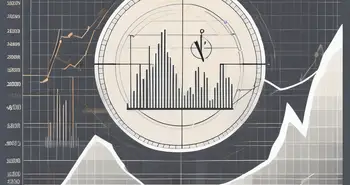Quantitative Tightening: How Central Banks Reduce Market Liquidity

Quantitative tightening (QT) is a term that has been buzzing around the financial world in recent years. As an expert in economics, I believe it is crucial to understand the implications of this policy on our economy. In this article, I will provide an in-depth analysis of quantitative tightening, its economic ramifications, and its potential future. So, let's dive right into it!
Understanding Quantitative Tightening
Quantitative tightening, also known as QT, refers to the process of reducing the size of a central bank's balance sheet. This reduction is achieved by selling the assets the central bank has acquired through its quantitative easing (QE) program. The purpose of QT is to control inflation and stabilize the economy by reducing the excess liquidity injected into the market during QE.
Definition and Purpose of Quantitative Tightening
When a central bank implements quantitative easing, it purchases government bonds and other securities from the market. This injection of liquidity stimulates economic activity by lowering interest rates and encouraging borrowing. However, as the economy recovers, excessive liquidity can lead to inflation. To counter this, central banks engage in quantitative tightening to remove that excess liquidity. The aim is to maintain price stability and prevent an overheating economy.
The Process of Quantitative Tightening
Quantitative tightening involves a gradual and strategic reduction of a central bank's balance sheet. It can be done through two primary methods: ceasing reinvestments and outright sales. Ceasing reinvestments means that when a bond matures, the central bank does not purchase a new one to replace it. Outright sales involve selling the bonds directly into the market. Both methods reduce the size of the central bank's balance sheet, withdrawing liquidity from the economy.
Let's delve deeper into the process of quantitative tightening. When a central bank decides to engage in QT, it carefully assesses the economic conditions and the level of excess liquidity in the market. This assessment helps the central bank determine the appropriate pace and magnitude of the tightening measures.
One of the key methods used in quantitative tightening is ceasing reinvestments. This approach allows the central bank to gradually reduce its balance sheet without causing significant disruptions in the financial markets. By not reinvesting the proceeds from maturing bonds, the central bank effectively reduces the amount of liquidity available in the market. This reduction helps to prevent inflationary pressures from building up and ensures a more balanced and sustainable economic growth.
In addition to ceasing reinvestments, central banks may also resort to outright sales of the assets they have acquired through QE. This method involves selling the bonds directly into the market, effectively removing liquidity from the system. The central bank carefully plans and executes these sales to minimize any potential negative impact on the financial markets. By strategically selling the assets, the central bank can control the pace of tightening and ensure a smooth transition towards a more normalized monetary policy.
It is important to note that the process of quantitative tightening is not a one-size-fits-all approach. Each central bank tailors its QT strategy based on the specific economic conditions and financial market dynamics of its jurisdiction. The timing and magnitude of the tightening measures are carefully calibrated to achieve the desired outcomes while minimizing any potential adverse effects on the economy.
Overall, quantitative tightening plays a crucial role in maintaining price stability and preventing an overheating economy. By carefully reducing the size of their balance sheets, central banks can effectively manage the level of liquidity in the market and ensure a sustainable and balanced economic growth in the long run.
The Economic Implications of Quantitative Tightening
Quantitative tightening has significant implications for various aspects of the economy. Let's explore some of the key areas affected:
Effects on Interest Rates
As central banks reduce their balance sheets through quantitative tightening, the increased supply of government bonds may push their prices down. When bond prices fall, the corresponding yields rise. This can lead to higher interest rates in the broader economy, making borrowing more expensive for individuals and businesses. Consequently, this can dampen economic growth.
Influence on Inflation and Deflation
Quantitative tightening aims to prevent excessive inflation. By withdrawing liquidity from the economy, it reduces the risk of an overheating economy and high inflation. However, the reduction in liquidity can also have the unintended consequence of exacerbating deflationary pressures. If central banks tighten their monetary policy too aggressively, they risk pushing the economy into deflation, where prices and wages decline, potentially leading to economic stagnation.
Impact on Stock Market
The stock market can be significantly affected by quantitative tightening. As central banks reduce their bond purchases and sell assets, it creates a decrease in liquidity. This reduction in liquidity can result in increased volatility and downward pressure on stock prices. Investors may anticipate a more challenging economic environment and adjust their investment strategies accordingly. However, it is worth noting that the stock market's reaction to QT can vary based on market sentiment and other economic factors.
Quantitative Tightening vs Quantitative Easing
It is essential to understand the differences between quantitative tightening and its predecessor, quantitative easing (QE). While QT is the process of reducing a central bank's balance sheet, QE involves expanding the balance sheet through the purchase of securities.
The Fundamental Differences
The fundamental difference between QE and QT lies in their objectives. QE is implemented during times of economic distress, aiming to stimulate the economy and prevent deflation. On the other hand, QT is employed when the economy is recovering, with the aim of gradually removing the excess liquidity injected during QE to prevent inflation.
Economic Effects Comparison
The economic effects of QE and QT are diametrically opposed. QE stimulates economic growth by increasing liquidity and lowering interest rates. It encourages borrowing, which drives investment and consumption. In contrast, QT aims to reduce liquidity and control inflation by raising interest rates and withdrawing the excess liquidity. The economic effects of QT can be contractionary, potentially dampening economic growth.
The Global Perspective on Quantitative Tightening
Quantitative tightening is not only relevant to individual economies but also has a global impact. Let's explore some of the key global implications:
Effects on Emerging Markets
Emerging markets can be particularly sensitive to changes in global interest rates and capital flows. As major central banks engage in quantitative tightening, interest rates rise, making investments in emerging markets comparatively less attractive. This can result in capital outflows, currency depreciation, and increased borrowing costs for emerging market economies.
Impact on Global Trade and Investment
Quantitative tightening can also impact global trade and investment flows. As central banks reduce liquidity and raise interest rates, it can lead to a stronger domestic currency. This stronger currency makes exports more expensive and imports relatively cheaper, potentially impacting a country's trade balance. Additionally, higher borrowing costs resulting from QT may deter foreign investment, affecting cross-border capital flows.
The Future of Quantitative Tightening
Looking ahead, the future of quantitative tightening remains uncertain. As central banks navigate the complexities of balancing price stability and economic growth, alternative approaches may arise. It is crucial to monitor and evaluate the long-term effects of QT to determine its effectiveness and potential refinements.
Predicted Long-Term Effects
While the long-term effects of quantitative tightening are still unfolding, experts predict various potential outcomes. These include a gradual normalization of interest rates, potential moderation of inflationary pressures, and a potential impact on asset prices and financial markets as liquidity is withdrawn.
Possible Alternatives to Quantitative Tightening
As central banks evaluate their monetary policy options, alternatives to quantitative tightening may emerge. These could include utilizing other tools, such as forward guidance or adjusting reserve requirements, to achieve the desired balance between monetary stimulus and price stability.
As an expert in economics, I strongly advise policymakers and individuals alike to closely monitor the impact of quantitative tightening on the economy. Understanding the nuances of this complex process is crucial for informed decision-making and effective policy formulation.
FAQs
What is quantitative tightening?
Quantitative tightening refers to the process of reducing the size of a central bank's balance sheet through the sale of assets acquired during quantitative easing. Its purpose is to control inflation and stabilize the economy.
How does quantitative tightening affect interest rates?
Quantitative tightening can lead to higher interest rates. As central banks sell their assets, it increases the supply of government bonds, potentially pushing their prices down and yields up. This, in turn, can result in higher borrowing costs for individuals and businesses.
What are the differences between quantitative tightening and quantitative easing?
Quantitative tightening and quantitative easing are opposite monetary policies. Quantitative easing involves expanding a central bank's balance sheet through the purchase of securities to stimulate economic growth. In contrast, quantitative tightening aims to reduce the balance sheet and withdraw liquidity to control inflation.
How does quantitative tightening impact emerging markets?
Quantitative tightening can lead to capital outflows, currency depreciation, and increased borrowing costs for emerging market economies. This is because higher interest rates in major economies make investments in emerging markets comparatively less attractive.
What are the potential long-term effects of quantitative tightening?
While the long-term effects are still unfolding, experts predict a gradual normalization of interest rates, potential moderation of inflationary pressures, and potential impacts on asset prices and financial markets as liquidity is withdrawn.
In conclusion, quantitative tightening is a policy that can have significant implications for the economy. Understanding its effects on interest rates, inflation, stock markets, and global dynamics is crucial for making informed decisions and adapting to the evolving financial landscape. As we continue to navigate the challenges of the post-QE era, closely monitoring the long-term effects and exploring alternative policy options will be key to ensuring economic stability and growth.
As we consider the complexities of quantitative tightening and its effects on the global economy, it's clear that the ability to adapt and respond to market changes is more important than ever. Morpher.com offers a revolutionary trading platform that empowers you to navigate these economic shifts with ease. With zero fees, infinite liquidity, and the flexibility of fractional investing and short selling, Morpher ensures you're equipped to take advantage of market opportunities, whether they arise from tightening monetary policies or other economic developments. Experience the future of trading with the safety and control of the Morpher Wallet, and amplify your trades with up to 10x leverage. Ready to transform your trading experience? Sign Up and Get Your Free Sign Up Bonus today, and join the vanguard of investors who are choosing innovation and user-centricity with Morpher.

Disclaimer: All investments involve risk, and the past performance of a security, industry, sector, market, financial product, trading strategy, or individual’s trading does not guarantee future results or returns. Investors are fully responsible for any investment decisions they make. Such decisions should be based solely on an evaluation of their financial circumstances, investment objectives, risk tolerance, and liquidity needs. This post does not constitute investment advice.

Painless trading for everyone
Hundreds of markets all in one place - Apple, Bitcoin, Gold, Watches, NFTs, Sneakers and so much more.

Painless trading for everyone
Hundreds of markets all in one place - Apple, Bitcoin, Gold, Watches, NFTs, Sneakers and so much more.









